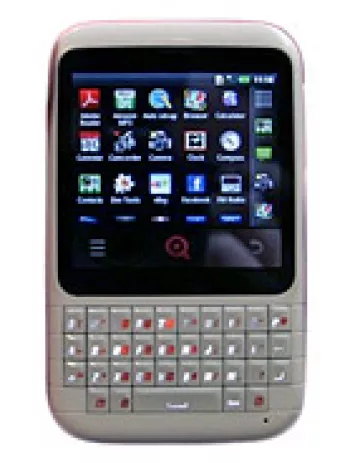
Introduction to iNQ Chat 3G
The iNQ Chat 3G, announced in October 2009 and released in December the same year, marks a distinctive entry in the era of 3G-enabled feature phones. Although discontinued today, it remains a noteworthy device that blended basic smartphone features with traditional phone functionality. With a unique QWERTY keyboard design, it catered to users who desired both easy typing options and cost-effective connectivity.
Design and Build
The iNQ Chat 3G is crafted with compactness and usability in mind, sporting dimensions of 114.5 x 61 x 12.8 mm and weighing just 122 grams. This lightweight and easy-to-handle device incorporated a physical QWERTY keyboard, a rare feature during its time of release, designed especially for text-centric users. The mini-SIM compatibility, familiar in its era, made it practical and accessible.
Display Features
Equipped with a TFT display supporting 256K colors, the iNQ Chat 3G provided reasonably vibrant visuals. Its 320 x 240 pixel resolution in a 4:3 ratio ensured users received acceptable clarity for viewing messages and basic images. This display type and resolution, while standard for the time, did not favor multimedia consumption but was adequate for the phone's intended usage.
Camera Capabilities
Photographic functionalities were limited, characteristic of feature phones of its time. The device was equipped with a 3.15 MP rear camera with autofocus, capable of capturing basic images and videos. However, the absence of advanced photographic technology meant it was more suited for occasional snaps rather than high-quality photography.
Storage and Memory
In terms of storage, the iNQ Chat 3G offered 100MB of internal memory, which was modest but expected for feature phones. However, the inclusion of a dedicated microSDHC slot provided expandable storage options, a critical feature for users needing more space for personal data and applications.
Network and Connectivity
The device supported GSM and HSPA technologies, covering 2G bands (GSM 900/1800/1900) and 3G bands (HSDPA 2100), ensuring decent connectivity options in its era. The HSPA 3.6/0.384 Mbps speed was satisfactory for standard internet browsing and messaging, although not ideal for multimedia streaming.
Connectivity options extended to Bluetooth 2.0 with A2DP, enabling wireless data transfer and audio streaming. The lack of WLAN and Radio connectivity was a downside, but the miniUSB 2.0 port allowed for basic wired connections.
Battery Life
The phone housed a removable Li-Ion 1150 mAh battery, providing adequate power for standard usage. While standby and talk time specifics aren't provided, the battery life was typically aligned with the minimal power draw of feature phones, allowing a relatively long duration of operation between charges.
Operating System and User Interface
Running on a basic feature phone OS, the iNQ Chat 3G focused on core functionalities such as SMS, MMS, Email, Instant Messaging, and Push GMail. It supported WAP 2.0/xHTML browsers and could run Java MIDP 2.0 applications, enhancing its utility as a communication-centric device rather than a multimedia powerhouse.
Market Position and Pricing
Launched at approximately 110 EUR, the iNQ Chat 3G was positioned as an affordable device with essential smart features. Available in Black and Red colors, it catered particularly to users who needed reliable communication tools without the higher cost of advanced smartphones.
Conclusion
The iNQ Chat 3G remains a fine example of transition phase phones before the widespread adoption of full-fledged smartphones. Its balance of a physical QWERTY keyboard, essential smart features, and economic pricing made it a compelling choice for specific user segments in its time. Although now discontinued, it holds a nostalgic place in the evolution of mobile communication.
Main Features of iNQ Chat 3G
- 3G connectivity with HSPA speeds of 3.6/0.384 Mbps
- Compact design with dimensions of 114.5 x 61 x 12.8 mm and a weight of 122g
- QWERTY keyboard for easy typing
- TFT display with 256K colors and a resolution of 320 x 240 pixels
- Expandable storage via microSDHC card slot
- 3.15 MP autofocus main camera with video recording capability
- Bluetooth 2.0 with A2DP
- Built-in GPS for positioning services
- Versatile messaging support including SMS, MMS, Email, IM, and Push GMail
- Java support (MIDP 2.0) for additional applications and games
- Removable Li-Ion 1150 mAh battery
- Available in Black and Red color options
- Affordable pricing at around 110 EUR
Disadvantages of iNQ Chat 3G
- Outdated 3G network support with limited speed (HSPA 3.6/0.384 Mbps).
- Discontinued status, making it difficult to find support or replacement parts.
- Lacks a front-facing camera for selfies or video calls.
- No WLAN capability, limiting internet connectivity to mobile networks only.
- Limited internal storage of 100MB, which may require frequent clearance.
- Does not support a 3.5mm headphone jack.
- No radio feature available.
- Display size is unspecified, possibly indicating a small screen.
- Older Bluetooth version (2.0), which may not be compatible with newer devices.
- Misses advanced sensors commonly found in modern smartphones.
- Mini-SIM usage may require an adapter for compatibility with current SIM card standards.

View Also
More Phones
All Rights Reserved +13693 Phones © Mobilawy 2025

















